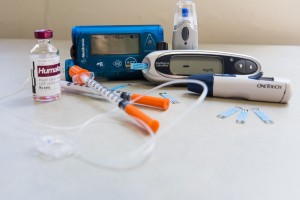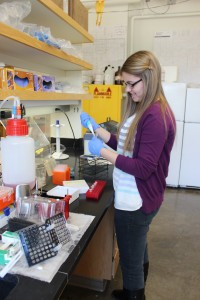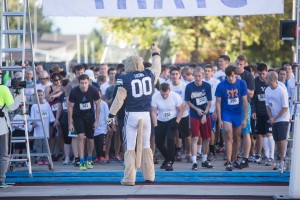
Twenty-nine million people in the United States have diabetes, according to a 2014 National Diabetes Statistics Report, and the number is on the rise.
November is National Diabetes Month, and at BYU curative research is underway to discover ways to combat both types of the disease.
Jeffery Tessem, an assistant professor in nutrition, dietetics and food science, said he has goals to defeat diabetes.
“We have two long-term goals: to make more beta cells for transplant and to enhance endogenous,” Tessem said.
He explained the beta cell is the particular cell type that goes awry in both forms of diabetes. The research in Tessem’s lab is focusing on making more beta cells to give back to diabetic patients so they are no longer dependent upon insulin secretions.
The report says only 21 million people are actually diagnosed with diabetes out of those 29 million people who have the disease. Of those diagnosed, 5 percent are type 1 diabetics and 95 percent are type 2.
Type 1 diabetes develops most often in young people, and is caused when the body’s immune system begins attacking the insulin-producing cells, according to the U.S. Department of Health. Type 2 diabetes is more likely to be developed in adults and those who are overweight or inactive, although it is occurring more often in children and young people. Both types of diabetes can develop in people of any age or gender, but type 2 is largely preventable by monitoring lifestyle habits.
Alyson Ludlow, a senior studying pre-communications at BYU, has lived with type 1 diabetes for the past 12 years. Ludlow had to quickly overcome her fear of needles and develop a habit of testing her blood sugar and delivering insulin injections every day as she was diagnosed with diabetes at 8 years old.
“All of my fingers have calluses on them. People always ask if it hurts and the finger pricking doesn’t, but the shots always hurt,” Ludlow said.

She explained that although her life is extremely affected by the disease, it seems invisible to others.
“People can’t see that you’re struggling. I go low in class and I have to get some sugar, or I’ll have a high blood sugar and can’t focus and still have to go to class and pretend that I’m ok,” Ludlow said. “It’s the worst because you feel like your body is trying to kill you and you can’t do anything about it but act like you’re ok and you aren’t.”
Ludlow explained the dangers of diabetes in an effort to better educate those unfamiliar with the disease. She said diabetics need to monitor their blood glucose levels closely and administer insulin or sugar appropriately everyday. She explained the ideal blood sugar range is between 70 and 120 milligrams per deciliter, but can vary for each diabetic.
Side effects of low blood glucose include drowsiness, sweating, blurred vision, nervousness, increased heart rate, dizziness and headaches, according to Ludlow. Low blood sugar is treated by administering sugar. She the effects of high blood glucose include increased thirst, frequent urination, headaches, blurred vision, nausea and fatigue. High blood glucose is treated with insulin administration.
“I feel like high blood sugar is obnoxious and low blood sugar is scary,” Ludlow said. “If diabetics administer too much insulin we risk going into a seizure or coma and if you don’t give yourself enough insulin you feel like you have the flu. It’s tough to balance.”
BYU researchers like Tessem said they are trying to make that balance easier for diabetics like Alyson. In effort to raise more funding for their research they hosted a five kilometer “Sugar Rush” run in September. He said the funds raised went directly towards buying resources such as tools, chemicals and testing animals, and to supporting students working in the labs.
The race brought runners from all over, each affected in some way by diabetes. Juncal Munez, a woman from Salt Lake City, said she was running for her brother and her niece that are suffering from type 1 diabetes.
Munez said that although she is not diabetic, she has a great desire to raise diabetes awareness because her brother’s life was saved by a roommate who was aware of her brother’s diabetes when his blood glucose dropped late one night.

“While my brother was attending college, his blood sugar dropped late one night and he was unable to help himself. Because of a roommate who had stayed up late writing a paper and because his roommate knew he had diabetes, he was able to provide my brother something to boost his blood sugar,” Munez said. “I’m so grateful that his roommate was awake and aware because it saved my brother.”
Parents were also on the run to show support for their children with diabetes. Tamara and Brad Bell from Lehi said they were running in support of their teenager who had been diagnosed at age 9. They described the struggle to find a balance in helping their son and letting their son help himself.
“It’s rough at times for our 14-year-old teenage boy to try and get control. It’s a big balance to try and figure out how much control to give him and how much we can still offer help and concern. He handles it really well but it’s still full of ups and downs,” Tamara Bell said.
Assistant professor of physiology and developmental biology Benjamin Bikman said the BYU diabetes research mission is to create a mechanism where funding can be provided to promote diabetes solutions and to provide diabetes awareness.
“We want to raise awareness for diabetes from a young child who is diagnosed with type 1 diabetes to the middle-aged individual diagnosed with prediabetes, to the elderly more mature individual with type 2,” Bikman said.
[Best_Wordpress_Gallery id=”281″ gal_title=”Diabetes Awareness Day”]




